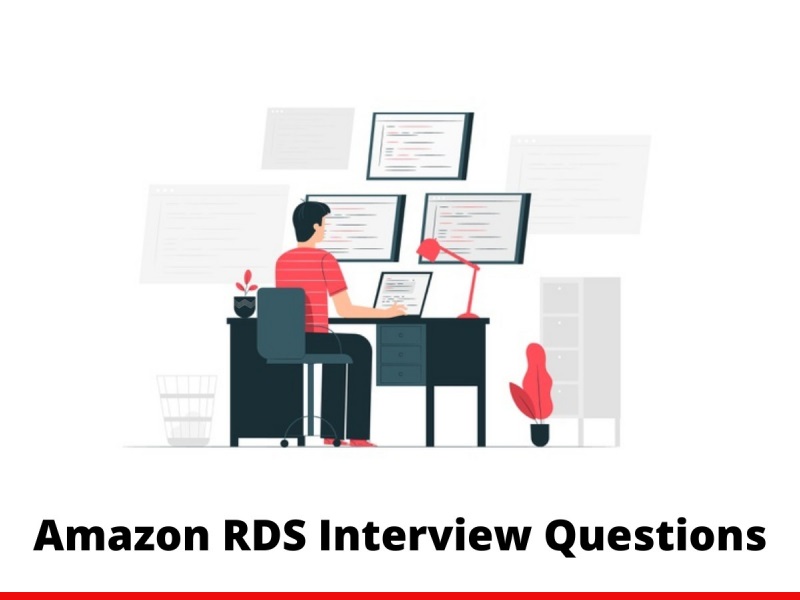Amazon RDS Interview Questions
 Download Amazon RDS Interview Questions PDF
Download Amazon RDS Interview Questions PDFBelow are the list of Best Amazon RDS Interview Questions and Answers
The Amazon RDS (Relational Database Service) is used to easily create a relational database in the cloud. This cross-platform database service was developed by Amazon and released in the year 2009. It also provides a way to manage the administrative processes like patching the database software, backing up databases and enabling point-in-time recovery. This proprietary tool by Amazon simplifies the process of creation, scaling and the use of the relational database in applications.
An instance is the basic building block of an RDS. It is an isolated database environment running in the cloud. The Amazon RDS manages the database instance by performing backups, handling failover, and maintaining the database software. Amazon RDS provides different instance types that are optimized to fit different relational database use cases. Instances types comprise varying combinations of CPU, memory, and other resources to give you flexibility in choosing the appropriate mix of resources for your database.
Some of the database engines supported by the Amazon RDS are,
- Amazon Aurora
- Postgre SQL
- MySQL
- MariaDB
- Oracle
- Microsoft SQL Server
Some of the features of the Amazon RDS are,
- It is easy to administer the project from conception to deployment using the Amazon RDS as there is no need for infrastructure provisioning or installing and maintaining the database software.
- Amazon RDS is highly scalable. You can increase the compute and storage resource with only a few mouse clicks or an API call.
- It is a highly reliable infrastructure as it synchronously replicates the data to a standby instance in a different availability zone.
- It offers performance on par with the commercial database at 1/10th the cost.
- It is highly secured as it lets you run database instances in Amazon Virtual Private Cloud.
- Using Amazon RDS is very cheap as the rates are very low and you get the benefit from the option of On-Demand pricing.
- It also has support for Multi-availability zone deployment.
A database instance is an isolated database environment that is running in the cloud. Users can set-up and manage multiple user-created databases within one instance. A DB instance is a set of memory structures that manages database files.
Amazon provides an RDS interface to access the RDS service. To work with the RDS service like accessing the data, uploading the data, and running some other programs need an RDS interface.
There are three main interfaces provided such as GUI Console, Command Line Interface, and AWS API.
A GUI Console is the simplest interface where users can easily work with the RDS Service.
Command Line Interface gives you CLI access where you can execute DB command to work with the service.
An AWS API provides an Application Programming Interface to pass information between two systems.
Some of the DB Storages supported by Amazon RDS are,
- Amazon Aurora
- MySQL,
- MariaDB
- Oracle
- SQL Server
- PostgreSQL database engine
Amazon Aurora is a type of relational database built for the cloud that is compatible with MySQL and PostgreSQL. It is five times faster than the MySQL database and three times faster than the PostgreSQL database. This hybrid database type is a perfect combination of the performance and availability of traditional databases with the simplicity and cost-effectiveness of the open-source database. This database is fully managed by the Amazon RDS so tasks like hardware provisioning, database setup, patching, and backups are automated.
Some of the better alternatives to the Amazon RDS are,
- Amazon Aurora
- Azure SQL Database
- Microsoft SQL Server
- Snowflake
- Oracle Database
- Google Cloud SQL
- MongoDB Atlas
- Oracle Exadata
- Oracle Database Cloud Service
An AWS Cluster consists of one or more RDS instances and a cluster volume to manage the data for the RDS instances. Aurora cluster is the popular one which creates two instances in a cluster by default. One instance is used to write while the other is used for reading operation. But you can change this configuration as you wish.
Amazon RDS is a PaaS as it only provides a platform or a set of tools to manage your database instances. AWS is Iaas, but the RDS provided by the AWS is PaaS.
There are two types of backups supported by Amazon RDS, such as automated backups and database snapshots.
The automated backup enables point-in-time recovery of your DB instance automatically.
A DB snapshot is a manual process to backup the DB instance. It can be done as frequently as you wish.
Latest Interview Questions-
Silverlight Interview Questions
-
Entity framework interview questions
-
LINQ Interview Questions
-
MVC Interview Questions
-
ADO.Net Interview Questions
-
VB.Net Interview Questions
-
Microservices Interview Questions
-
Power Bi Interview Questions
-
Core Java Interview Questions
-
Kotlin Interview Questions
-
JavaScript Interview Questions
-
Java collections Interview Questions
-
Automation Testing Interview Questions
-
Vue.js Interview Questions
-
Web Designing Interview Questions
-
PPC Interview Questions
-
Python Interview Questions
-
Objective C Interview Questions
-
Swift Interview Questions
-
Android Interview Questions
-
IOS Interview Questions
-
UI5 interview questions
-
Raspberry Pi Interview Questions
-
IoT Interview Questions
-
HTML Interview Questions
-
Tailwind CSS Interview Questions
-
Flutter Interview Questions
-
IONIC Framework Interview Questions
-
Solidity Interview Questions
-
React Js Interview Questions
Subscribe Our NewsLetter
Never Miss an Articles from us.
